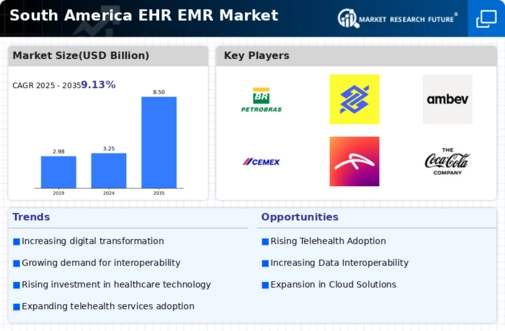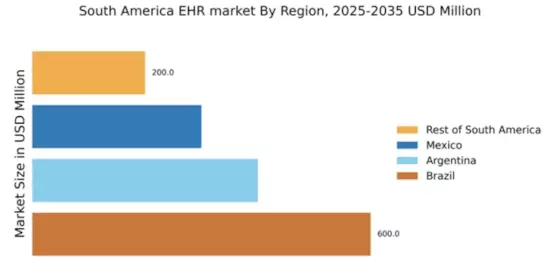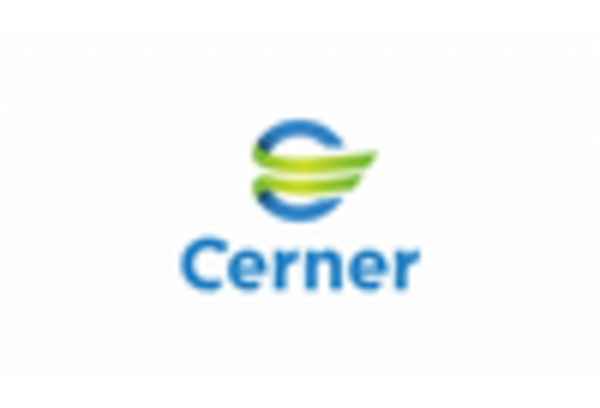Growing Focus on Data Interoperability
The ehr emr market in South America is witnessing a growing emphasis on data interoperability among healthcare systems. Interoperability allows for seamless data exchange between different healthcare providers, which is essential for coordinated patient care. As healthcare systems become more interconnected, the demand for ehr emr solutions that facilitate interoperability is increasing. In 2025, it is projected that over 70% of healthcare organizations in South America will prioritize interoperability in their ehr emr systems. This trend is driven by the need for comprehensive patient records that can be accessed by various stakeholders, including hospitals, clinics, and specialists. Enhanced data sharing capabilities not only improve patient outcomes but also reduce healthcare costs by minimizing redundant tests and procedures.
Technological Advancements in Healthcare
The ehr emr market in South America is experiencing a surge due to rapid technological advancements. Innovations such as cloud computing, artificial intelligence, and machine learning are transforming healthcare delivery. These technologies enhance data management, improve patient outcomes, and streamline administrative processes. For instance, the integration of AI in electronic health records allows for predictive analytics, which can lead to better clinical decisions. As of 2025, the market is projected to grow at a CAGR of approximately 12%, driven by these technological improvements. Furthermore, the adoption of mobile health applications is increasing, enabling healthcare providers to access patient data remotely, thus enhancing the efficiency of care delivery. This trend indicates a shift towards more integrated and patient-centered healthcare solutions.
Rising Awareness of Health Data Management
The ehr emr market in South America is experiencing growth due to rising awareness of the importance of health data management. Healthcare providers are increasingly recognizing the value of accurate and accessible patient data for improving clinical outcomes. This awareness is driving the adoption of ehr emr systems that enable better data collection, storage, and analysis. As of 2025, it is anticipated that approximately 60% of healthcare organizations will implement ehr emr solutions to enhance their data management capabilities. This trend is further supported by educational initiatives aimed at healthcare professionals, emphasizing the benefits of effective health data management. Improved data management not only enhances patient care but also supports research and public health initiatives, thereby contributing to the overall advancement of the healthcare sector.
Regulatory Changes and Compliance Requirements
The ehr emr market in South America is significantly influenced by evolving regulatory frameworks and compliance requirements. Governments are implementing stricter regulations to ensure data security and patient privacy, which necessitates the adoption of advanced electronic health record systems. Compliance with regulations such as the General Data Protection Regulation (GDPR) in certain countries is becoming crucial for healthcare providers. This has led to an increased demand for ehr emr solutions that offer robust security features. As of 2025, it is estimated that compliance-related investments in the healthcare sector will reach $1 billion, highlighting the importance of regulatory adherence. Consequently, healthcare organizations are prioritizing the implementation of ehr emr systems that not only meet regulatory standards but also enhance operational efficiency.
Increased Investment in Healthcare Infrastructure
The ehr emr market in South America is benefiting from increased investment in healthcare infrastructure. Governments and private entities are allocating substantial funds to modernize healthcare facilities and adopt advanced technologies. This investment is crucial for enhancing the quality of care and expanding access to healthcare services. As of 2025, it is estimated that healthcare spending in South America will reach $500 billion, with a significant portion directed towards digital health initiatives. This influx of capital is likely to accelerate the adoption of ehr emr systems, as healthcare providers seek to improve operational efficiency and patient engagement. Furthermore, the establishment of new healthcare facilities equipped with modern technology is expected to create additional demand for ehr emr solutions.


















Leave a Comment